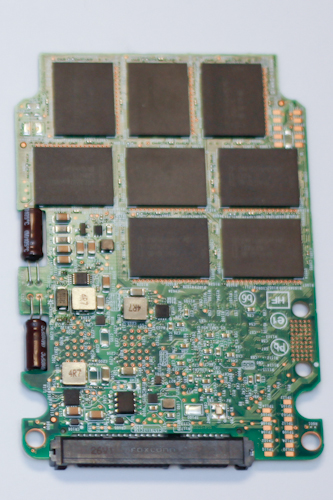Intel SSD DC S3700 Review: Benchmarking Consistency
With the recent announcement of the SSD DC S3700, Intel is firmly targeting enterprise customers with something not normally seen on spec sheets: performance consistency. Will their latest offering live up to expectations, or fall short? Lets find out.
Power Consumption
The SSD DC S3700 is a unique product for Intel. It's the first drive able to operate on both the +5 V and +12 V power rails. When you look at the PCB, you can clearly see the inductors for the power supply circuitry. This gives Intel a lot more flexibility in terms of deployment.
If there is one thing that hurts the SSD DC S3700, particularly when you consider how it's going to be used, power consumption would be it. As you can see in the table below, the maximum RMS (root mean squared) burst power draw is 8.2 W, while the average is 5.8 W (6 W on the +12 V rail). That's quite a bit more than Intel's SSD 710, which, for the 200 GB model, typically drew 3.5 W. It looks even worse compared tot he SSD 520, which has an active power draw of only 0.85 W.
When you multiply out that additional power use across dozens of drives or more, it may become necessary to keep a rack full of storage on a tighter power budget.
| Intel SSD DC S3700 | 100 GB | 200 GB | 400 GB | 800 GB |
|---|---|---|---|---|
| +5 V Supply (+12 V Supply) | ||||
| Active Write: RMS Average | 2.8 (2.9) W | 4.2 (4.4) W | 5.2 (5.4) W | 5.8 (6.0) W |
| Active Write: RMS Burst | 3.1 (3.3) W | 4.6 (4.8) W | 7.7 (7.6) W | 8.2 (8.2) W |
| Idle | 0.6 (0.8) W |
We took a look at the 800 GB model and confirmed that Intel's numbers are correct; this drive is closer to a Hummer than a Prius.
Get Tom's Hardware's best news and in-depth reviews, straight to your inbox.
Current page: Power Consumption
Prev Page Results: Enterprise Video Streaming Performance Next Page Intel's SSD DC S3700 Redefines The Way We Look At Performance-
merikafyeah Consistency and reliability are always more important to me than speed and capacity,Reply
but it's wonderful when you can have all four.
Kudos to Intel for raising the bar yet again on SSD quality. Eagerly awaiting trickle-down effect. -
InvalidError adgjlsfhkhow does ssd power consumption compare to an hhd's in watts per gigabyte?For conventional 3.5" HDDs, you have 5-8W idle, 10-15W seek and 15-25W spin-up.Reply
For 2.5" HDDs, you have ~1W idle and 2-2.5W seek/spin-up.
I'm a little surprised at how much power Intel's enterprise SSDs are using. I'm guessing a good chunk of the reason comes from having extra circuitry to do the double-conversion from 5/12V to ~30V and then back down to whatever the SSD needs. -
drewriley InvalidErrorFor conventional 3.5" HDDs, you have 5-8W idle, 10-15W seek and 15-25W spin-up.For 2.5" HDDs, you have ~1W idle and 2-2.5W seek/spin-up.I'm a little surprised at how much power Intel's enterprise SSDs are using. I'm guessing a good chunk of the reason comes from having extra circuitry to do the double-conversion from 5/12V to ~30V and then back down to whatever the SSD needs.Reply
You nailed it. If you look at 2.5" 15K and 10K RPM drive, the Intel is better on W/GB, but it is pretty high when compared to other SSDs. -
master9716 Samsung aint gona mess around , they are going to bring this type of performance to Desktops watch .Reply
-
sanilmahambre So this is why they gave up on motherboards and concentrated more on SSD's! Believe me that trick worked wonders and a lot more money.. LOLReply -
mayankleoboy1 adgjlsfhkhow does ssd power consumption compare to an hhd's in watts per gigabyte?Reply
i am not sure if watt/GB is important for storage.
Reason : the new philosophy is to "hurry up, finish the work, and relax".
